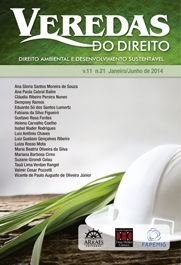POUSIO: o que é e quais são os seus possíveis reflexos nas questões ambientais
Main Article Content
Abstract
Este artigo analisará o processo legislativo de construção do novo Código Florestal, desde seu início em 1999, como Projeto de Lei da Câmara dos Deputados, passando pelo Senado Federal, retornando à Casa Iniciadora, até seu veto parcial pela Presidência da República em 2012, e a edição da Medida Provisória nº 571, de 2012, com especial atenção para uma técnica pouco conhecida: o pousio. O objeto é demonstrar como o pousio foi significativamente alterado durante todo o processo. Após analisar o trajeto legislativo percorrido por esse conceito, será feita uma leitura da sua regulamentação final, em conformidade com os princípios fundamentais da Constituição de 1988 como a função social da propriedade e o dever de preservação para as gerações atuais e futuras.
Â
Abstract
This article will examine the legislative process of building the Brazilian New Forest Code, since its inception in 1999, as Bill of the House of Representatives passing the Senate, returning to the House Initiator until his partial veto by the president in 2012, and issue of Medida Provisória nº. 571, 2012, with special attention to one unknown term: the pousio. The object is to demonstrate how the pousio was significantly changed throughout the process. After reviewing the legislative elaboration traversed by this concept, there will be a reading of its final rule in accordance with the fundamental principles of the 1988 Brazilian Constitution as the social function of property and duty of preservation for present and future generations.
Â
Keywords
Pousio; Brazilian Forest Code; Legislative Process; Constitution.
Article Details
I (we) submit this article which is original and unpublished, of my (our) own authorship, to the evaluation of the Veredas do Direito Journal, and agree that the related copyrights will become exclusive property of the Journal, being prohibited any partial or total copy in any other part or other printed or online communication vehicle dissociated from the Veredas do Direito Journal, without the necessary and prior authorization that should be requested in writing to Editor in Chief. I (we) also declare that there is no conflict of interest between the articles theme, the author (s) and enterprises, institutions or individuals.
I (we) recognize that the Veredas do Direito Journal is licensed under a CREATIVE COMMONS LICENSE.
Licença Creative Commons Attribution 3.0



































